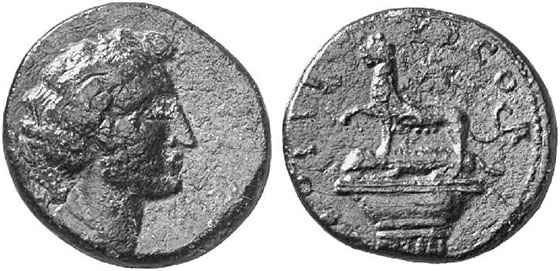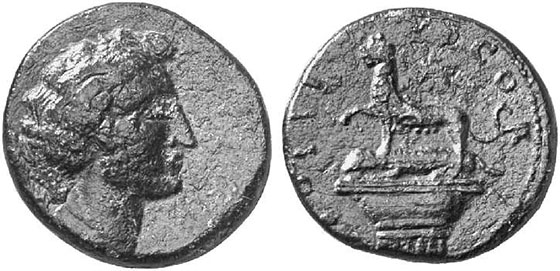The courtesan Laïs in Corinth
Greek writer Pausanias, in the 2nd cent., describes his visit to Corinth as follows: “As one goes up to Corinth are tombs, and by the gate is buried Diogenes of Sinope, whom the Greeks surname the Dog. Before the city is a grove of cypresses called Craneum. Here are a precinct of Bellerophontes, a temple of Aphrodite Melaenis and the grave of Laïs, upon which is set a lioness holding a ram in her fore-paws. There is in Thessaly another tomb which claims to be that of Laïs, for she went to that country also when she fell in love with Hippostratus. The story is that originally she was of Hycara in Sicily. Taken captive while yet a girl by Nicias and the Athenians, she was sold and brought to Corinth, where she surpassed in beauty the courtesans of her time, and so won the admiration of the Corinthians that even now they claim Laïs as their own.” (Pausanias 2.2.4-5, as translated by W. H. S. Jones).
Corinth (Achaea), AE, Hadrian, 117-138. Rev.: tomb of Laïs: capital of a Doric column with a ram on top, lioness above. BMC 692 var. and pl. XXIII.12. SNG Cop. 294 var. From auction Numismatik Lanz Munich 109 (2002), no. 200.
A column, a lioness above with a ram between her paws; we would be unable to make head or tail of that if it wasn’t for Pausanias’ detailed description of Corinth’s points of interest. He tells us that immediately before the city gates – perhaps you remember that it was forbidden to bury anyone inside the city – two important tombs could be visited: the one of Diogenes and the one of Laïs. The latter he describes at such length that we can read our coin as an illustration of this tomb.
But who was this Laïs whom the citizens of Corinth were so proud of, even centuries after her death, that they depict her tomb on their coins?
“I contain her who in Love’s company luxuriated in gold and purple, more than tender Cypris, Lais, the citizen of sea-girt Corinth, brighter than the white waters of Pirene; that mortal Cytherea who had more noble suitors than the daughter of Tyndareus, all plucking her mercenary favours. Her very tomb smells of sweet-scented saffron; her bones are still soaked with fragrant, and her anointed locks still breathe a perfume as of frankincense. For her Aphrodite tore her lovely cheeks, and sobbing Love groaned and wailed. Had she not made her bed the public slave of gain, Greece would have battled for her as for Helen.” (Antipatros of Sidon, Greek Anthology 7.218, as translated by W. R. Paton, Loeb Classical Library 68, 1917.)
Laïs was engaged in the oldest profession of the world: she was a courtesan (hetaera). And a very good one at that. That was something of a family tradition. Already her mother Timandra had seduced fastidiously Alcibiades. As long as she was young and could afford it, she was said to be expensive and particular. Her hardship and her high prices were generally known. She became famous due to her associating with important men. She was especially taken with philosophers. Diogenes, the Cynic, was one of her customers; since he had no financial means whatsoever she let him enjoy her service for free. For Aristippos of Cyrene, in contrast, she made it costly. But he was a man who could afford it being one of the most famous and celebrated philosophers of his time. Each year, he travelled to Aegina for two months, where she was at his disposal at his ‘consort’, as venal mistress for precious gifts.
But, Laïs, too became a victim of old age. She was forced to reduce her prices, became a drunkard and worked as a pander:
“The letter Y signifies four hundred, but your years are twice as much, my tender Lais, as old as a crow and Hecuba put together, grandmother of Sisyphus and sister of Deucalion. But dye your white hair and say “tata” to everyone.” (Greek Anthology 11.67, as translated by W. R. Paton, Loeb Classical Library 85, 1918)
Corinth (Achaea), AE, Geta, 209-211. Rev.: tomb of Laïs: capital of a Doric column with a ram on top, lioness above. Weber 3812 (same die). From auction Numismatik Lanz Munich 109 (2002), no. 649.
Let’s call a spade a spade. The citizens of Corinth had the tomb of a famous prostitute, surrounded by scandal, depicted on their coins. Remarkable. The reason for that is a human quality you can still notice in every tour group. You may well give a lecture on artistic styles and history, on buildings and culture – the undivided attention of the entire group, however, you will only get when you come up with a juicy scandal. Which English king is known to any child? That’s right, Henry VIII, but not due to his founding of the Church of England but because he had six wives.
In Corinth, it was something similar. The Romans had discovered Greece as tourist destination. To this country they undertook educational trips which were not really different from what we today know from popular tourist destinations. Particularly notorious were the tour guides who lied their head off and raked in considerable tips from the wide-eyed Romans. They spiced up their little tales with a couple of solid scandalous stories and of course didn’t miss out the tomb of Laïs. Pausanias who had written the introductory text above, in contrast, wanted to provide the reader thirsting for education with reliable information on places of interest in Greece. The famous tomb of Laïs, however, he couldn’t and didn’t want to omit.
Thus, this coin depicts a kind of landmark of Corinth, a monument that, strictly speaking, is of no artistic value, like, for example, Manneken Pis in Brussels, Hofbräuhaus in Munich or Eiffel Tower in Paris. There was no harm in advertising with this motif. Excavation finds testify that coins were often stored far away from where they had been produced, probably as a kind of souvenir that could be used to show the friends the places one had already been to – please keep in mind there was no such thing as photography invented yet. The coins with the tomb of Laïs most surely were a particularly popular reminder and hence dispersed the image of Corinth as a stronghold of tourism.









